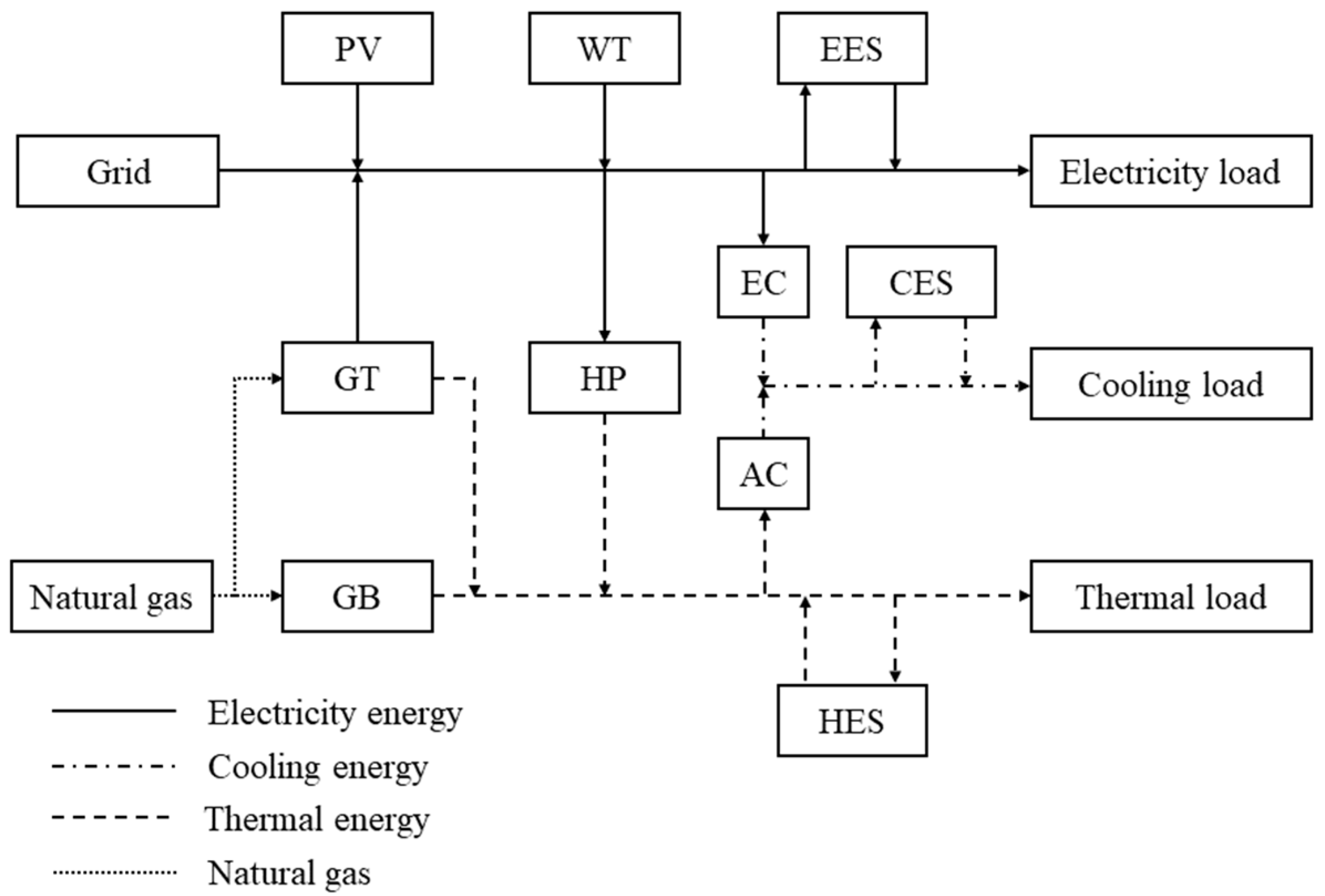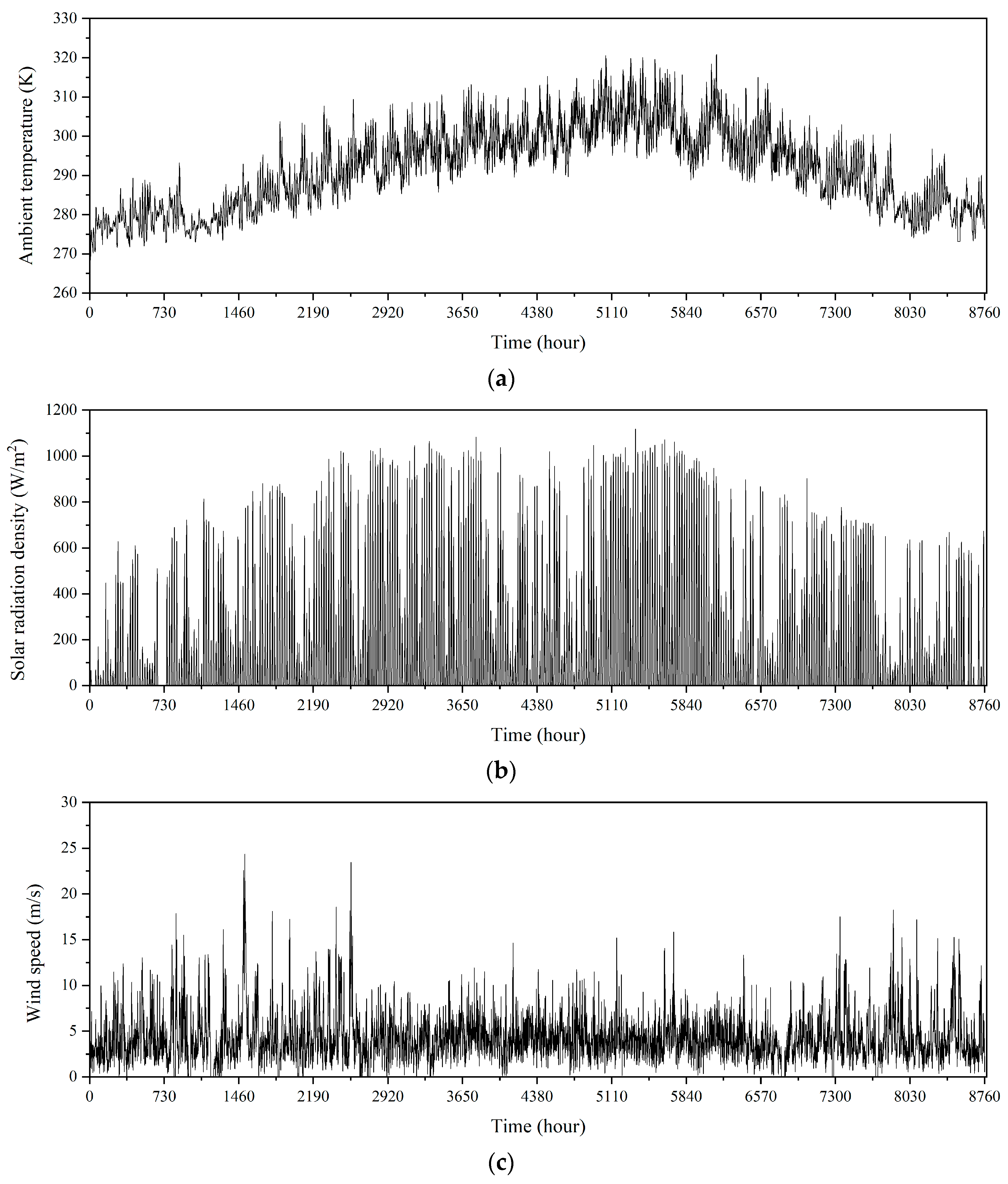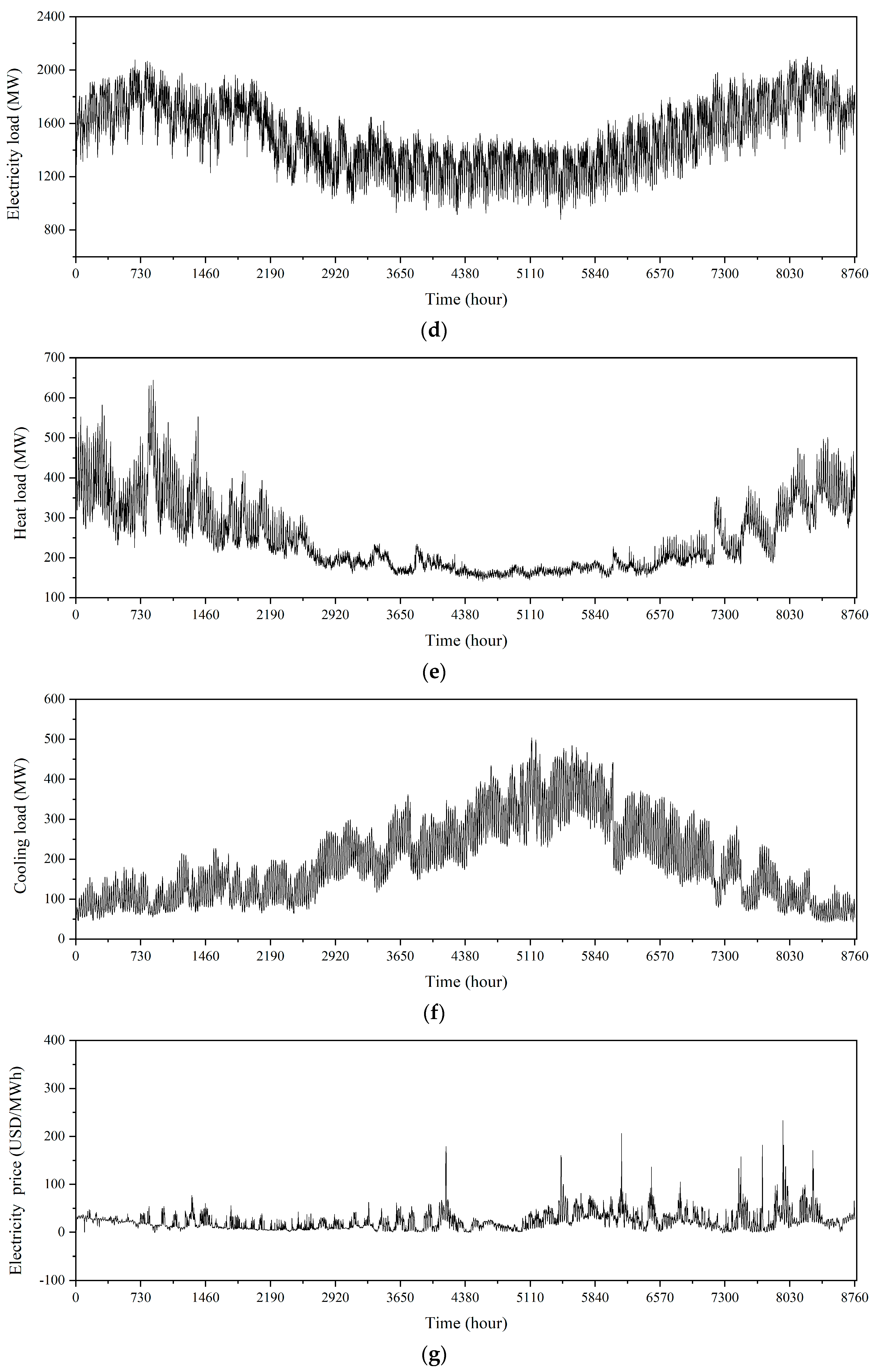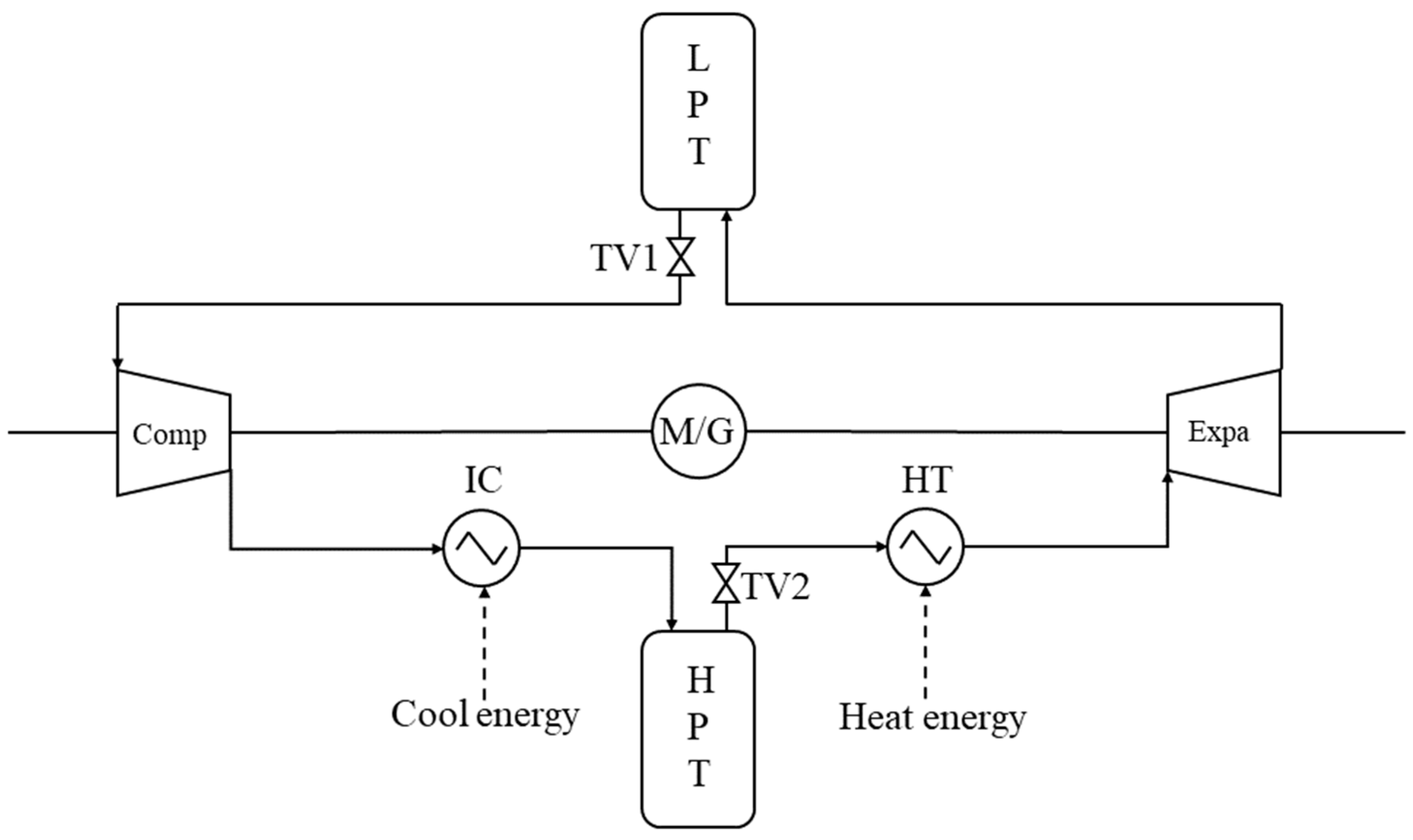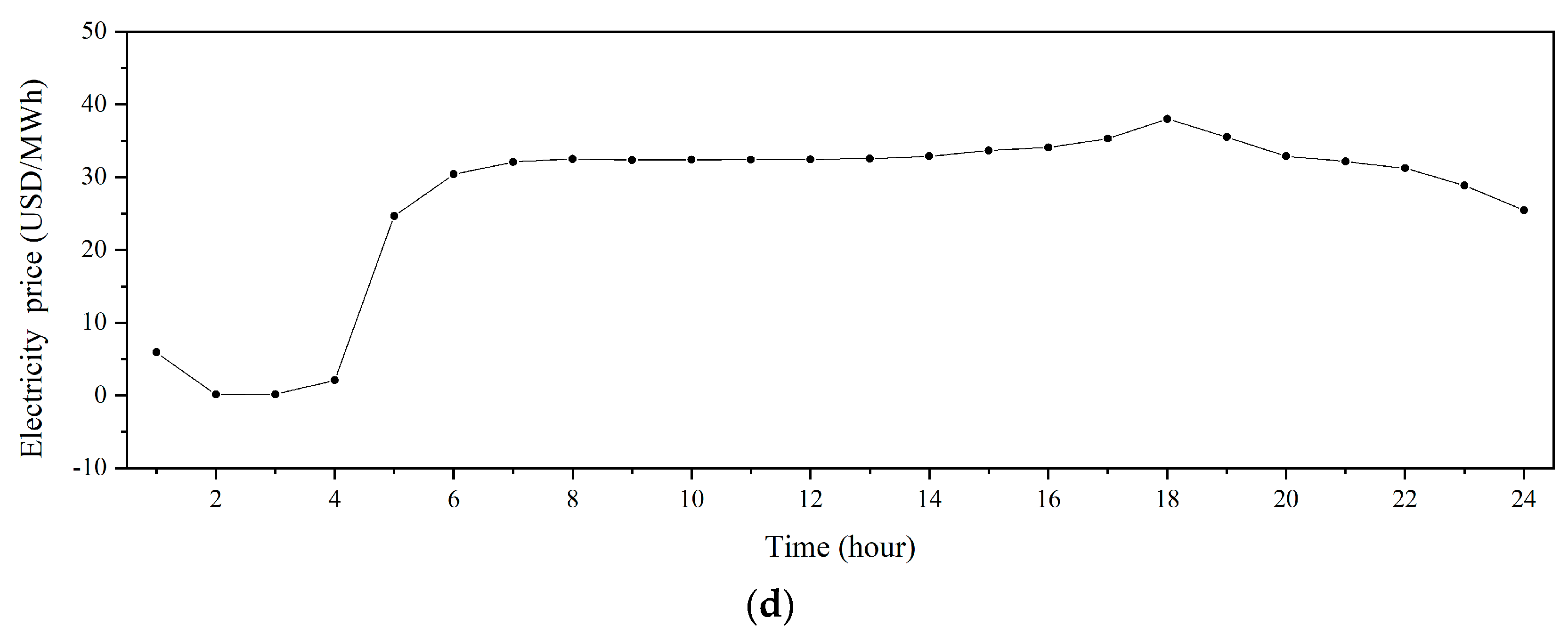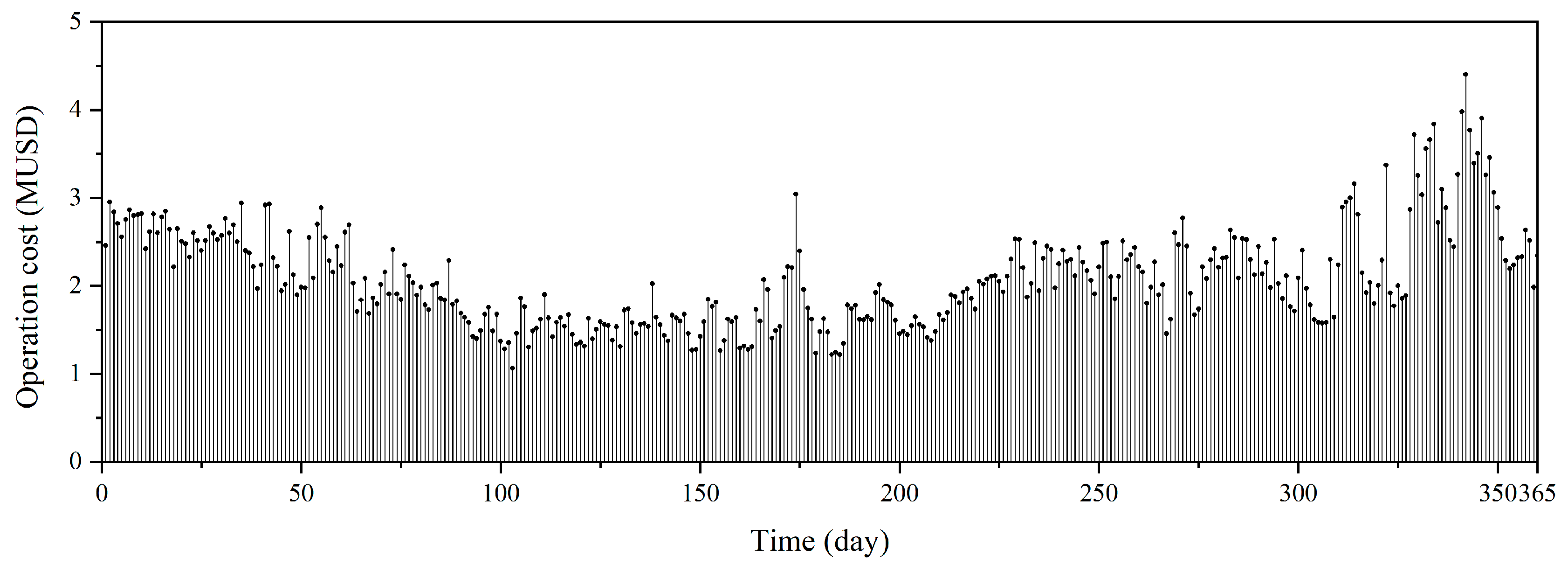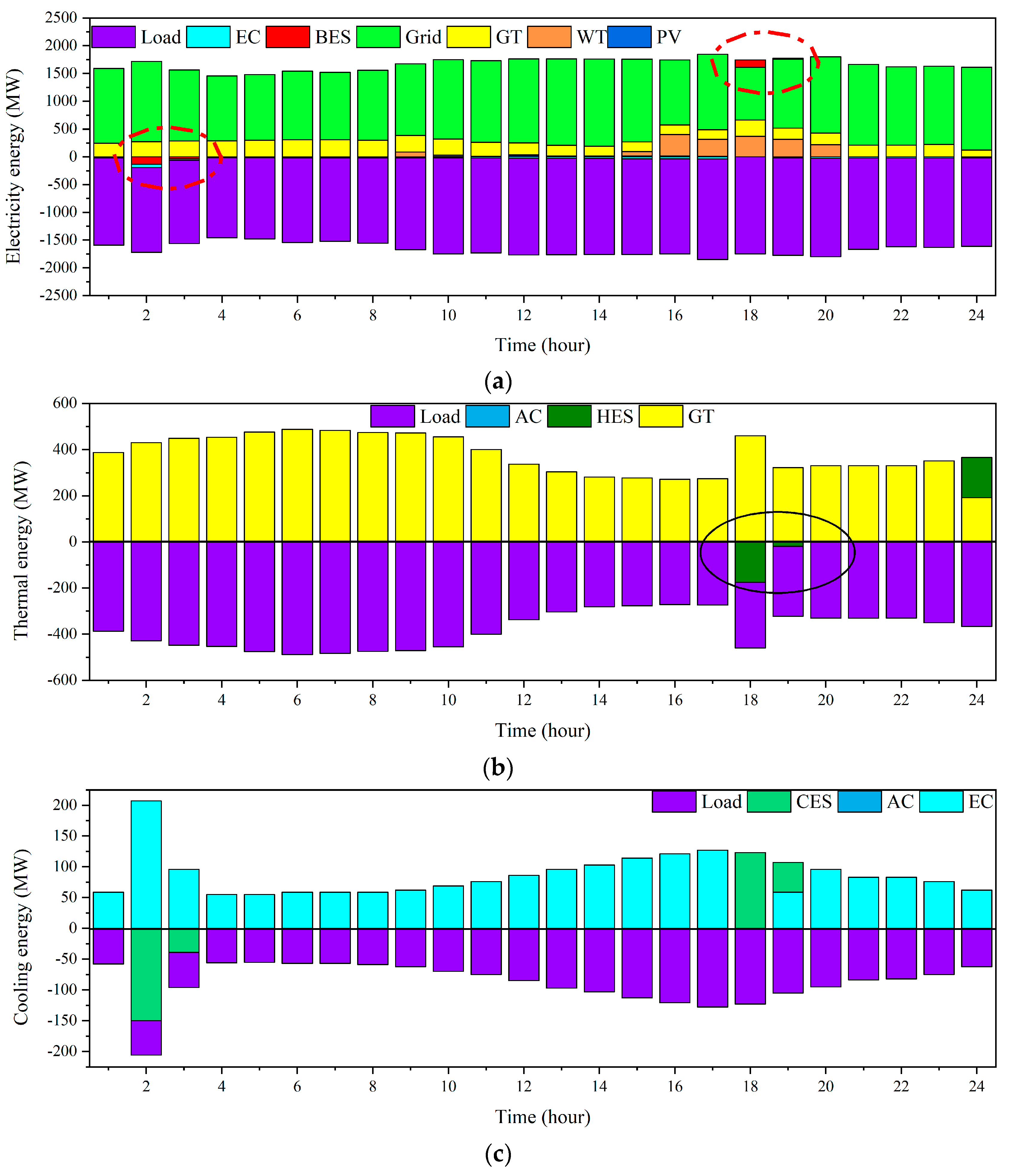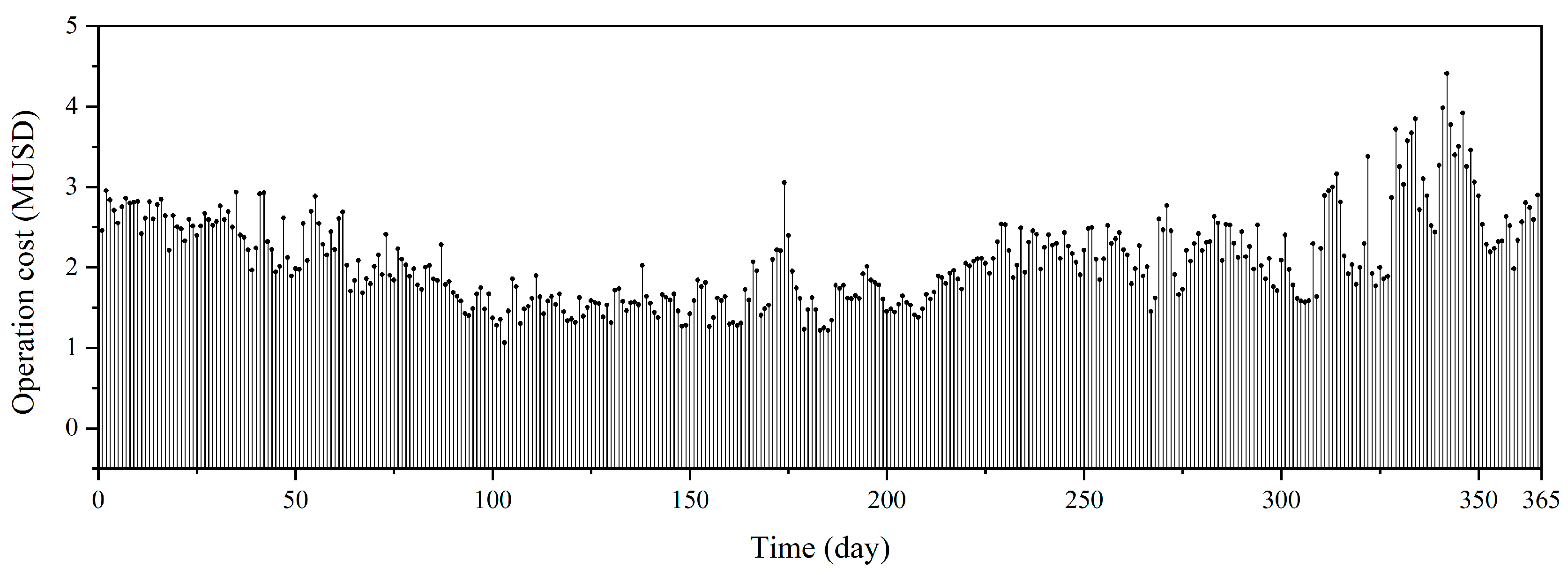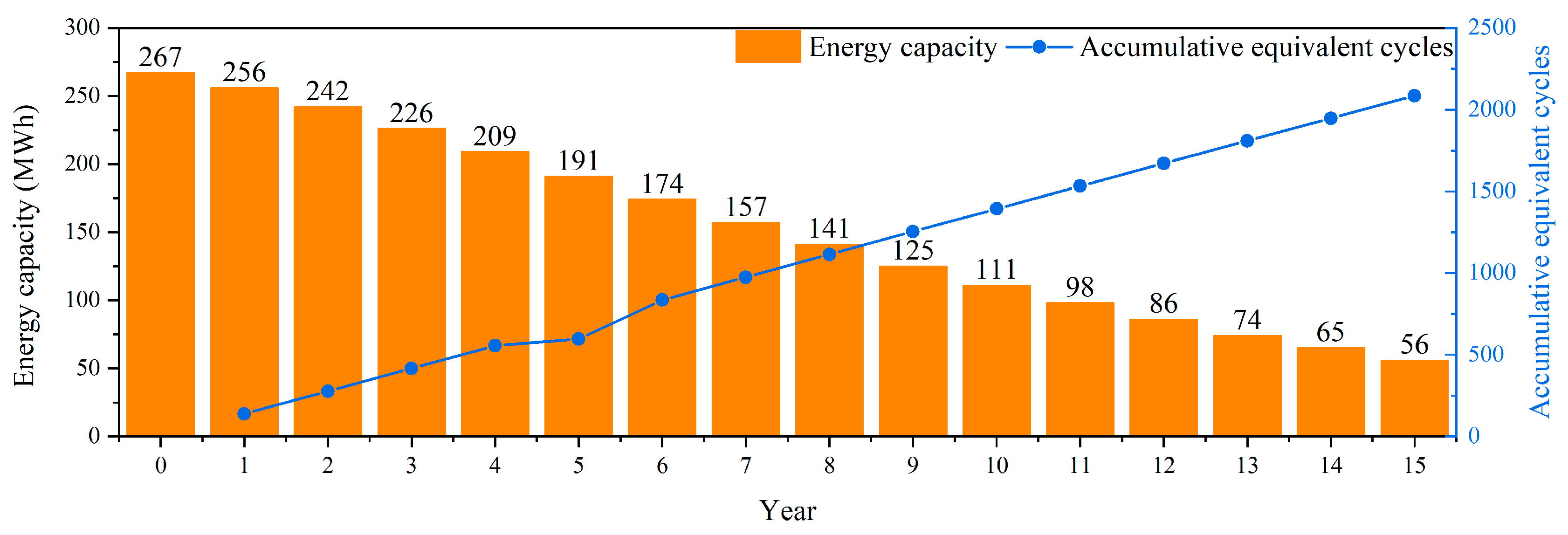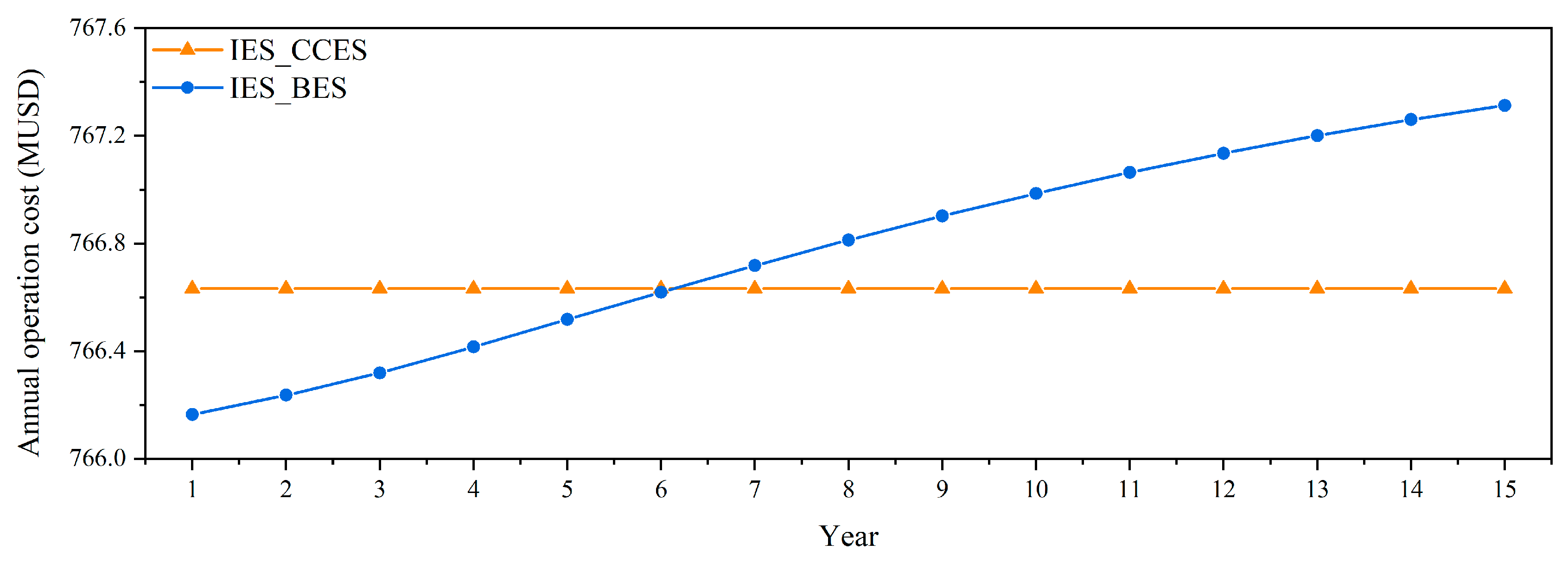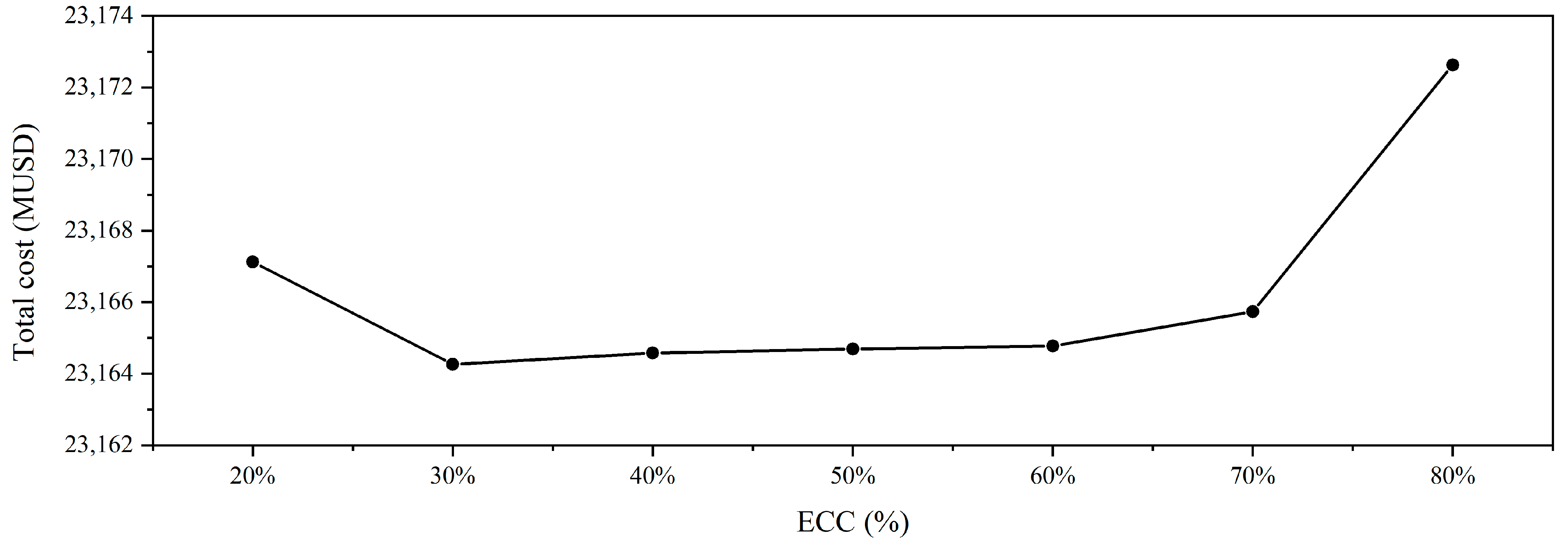2.2.2. Constraints
- (1)
Photovoltaic Constraint
The PV output is determined by the solar radiation intensity, ambient temperature, and system’s physical installation parameters, as indicated in Formula (5). Moreover, the output is constrained by the installation capacity, as depicted by Formulas (7) and (8):
where
is the PV output,
is the PV rated output,
is the solar radiation intensity,
is the solar radiation intensity under standard conditions,
is the temperature coefficient,
is the surface temperature of the PV,
is the surface temperature of the PV under standard conditions,
is the ambient temperature,
is the installation capacity, and
is the maximum installation capacity of the PV.
- (2)
Wind turbine constraint
The output of a wind turbine, represented by Formula (9), is contingent upon the wind speed. Furthermore, the output is bounded by the installed capacity, as illustrated by Formulas (10) and (11):
where
is the output of the wind turbine,
is the wind speed,
is the cut in wind speed,
is the cut out wind speed,
is the rated wind speed,
is the rated output of the wind turbine,
is the installation capacity of the wind turbine, and
is the maximum installation capacity of the wind turbine.
- (3)
Gas turbine constraints
A gas turbine was employed to produce electricity and thermal energy through the consumption of natural gas. The electrical and thermal outputs are denoted by Formulas (12) and (13), respectively. Additionally, the output of the gas turbine was subject to limitations imposed by its installed capacity, as expressed by Formulas (14) and (15):
where
is the thermal energy generated by the gas turbine,
is the calorific value of the natural gas,
is the amount of natural gas consumed by the gas turbine,
is the thermal efficiency of the gas turbine,
is the electrical energy generated by the gas turbine,
is the electrical efficiency of the gas turbine,
is the installation capacity of the gas turbine, and
is the maximum installation capacity of the gas turbine.
- (4)
Gas boiler constraints
Thermal energy can be produced by a gas boiler through the consumption of natural gas, as represented by Formula (16). Moreover, the thermal energy generated by a gas boiler is subject to limitations imposed by its installed capacity, as shown by Formulas (17) and (18):
where
is the thermal energy generated by the gas boiler,
is the amount of natural gas consumed by the gas boiler,
is the installation capacity of the gas boiler, and
is the maximum installation capacity of the gas boiler.
- (5)
Electric chiller constraints
An electric chiller employs electrical energy to produce cooling energy, as illustrated by Formula (19). The output of an electric chiller is constrained by its installed capacity, as indicated by Formulas (20) and (21):
where
is the cooling energy generated by the electric chiller,
is the electrical energy consumed by the electric chiller,
is the electric chiller’s coefficient of performance,
is the installation capacity of the electric chiller, and
is the maximum installation capacity of the electric chiller.
- (6)
Adsorption chiller
An adsorption chiller utilizes thermal energy absorption for the production of cooling energy, as denoted by Formula (22). The output of an adsorption chiller is constrained by its installed capacity, as represented by Formulas (23) and (24):
where
is the cooling energy generated by the adsorption chiller,
is the thermal energy consumed by the adsorption chiller,
is the efficiency of the adsorption chiller,
is the installation capacity of the adsorption chiller, and
is the maximum installation capacity of the adsorption chiller.
- (7)
Heat pump
A heat pump was employed for thermal energy generation through the consumption of electrical energy, as represented by Formula (25). The constraints on the heat pump’s output are detailed by Formulas (26) and (27):
where
is the thermal energy generated by the heat pump,
is the electrical energy consumed by the heat pump,
is the heat pump’s coefficient of performance,
is the installation capacity of the heat pump, and
is the maximum installation capacity of the heat pump.
- (8)
Electrical energy storage constraints
The constraints on the electrical energy storage encompassed the operation mode constraint and electric capacity constraints. The operation mode constraints for the electrical energy storage are articulated by Formula (28), signifying that the electrical energy storage system could operate in only one mode at a time, i.e., in charging, discharging, or idle mode, as follows:
where
and
are the charging and discharging indicators of the electrical energy storage system, respectively.
The electrical capacity constraint specified that the charging and discharging capacities of the electrical energy storage system were limited by their respective maximum charging and discharging capacities, as expressed by Formulas (31) and (32):
where
is the charging capacity of the electrical energy storage system,
is the discharging capacity of the electrical energy storage system,
is the maximum charging capacity of the electrical energy storage system, and
is the maximum discharging capacity of the electrical energy storage system.
Meanwhile, the charging and discharging capacities of the electrical energy storage were constrained by both its installation capacity and state of charge (SOC), as depicted below:
where
is the installation capacity of the electrical energy storage system,
is the maximum installation capacity of the electrical energy storage system,
is the capacity coefficient,
is the SOC of the electrical energy storage system,
is the charging efficiency,
is the discharging efficiency and
and
are the minimum and maximum values of the SOC, respectively.
- (9)
Battery energy storage constraints
When employing a battery as the electrical energy storage system in an IES, irreversible capacity loss occurs due to diverse physical and chemical changes that are contingent on the battery’s lifecycle, environmental factors, and usage conditions [
27]. The capacity loss of a battery encompasses calendar loss and cycle loss, as indicated by Formulas (38) and (39) [
28]. Consequently, the energy storage capacity of a battery is constrained by both calendar and cycle loss as shown in Formula (40):
where
is the calendar capacity loss,
is the influence coefficient under the reference temperature and SOC,
is the activation energy,
is the gas constant,
is the temperature,
is the reference temperature,
is the coefficient regarding the SOC,
is the influence coefficient regarding the time,
is the cycle capacity loss,
the coefficient regarding the mean SOC,
is the coefficient regarding the
,
is equivalent to full cycles, and
is a coefficient.
- (10)
Compressed CO2 energy storage system constraints
When utilizing a CCES system as an electrical energy storage system in an IES, the charging and discharging capacities of the CCES system are additionally constrained by its SOC, which was provided for in our previous study and is expressed by Formulas (41) to (44) [
25]:
where
is the mass flow rate of the compressor,
is the duration of a single time interval at which the compressor and the expander operate,
is the total mass of the CO
2 in the high-pressure gas tank,
is the maximum SOC of the CCES system at a certain compressor’s electric capacity (
),
is the duration of the charging process if the CCES system charges at the constant electric capacity
,
is the mass flow rate of the expander,
is the minimum SOC of the CCES system at a certain expander’s electric capacity, and
is the duration of the discharging process if the CCES system discharges at the constant electric capacity
.
The definition of the SOC for the CCES system is presented by Formula (45), and the SOC must adhere to the constraint outlined in Formula (46):
where
is the stored mass of the CO
2 at the time
in the high-pressure gas tank.
- (11)
Thermal and cooling energy storage constraints
The constraints on the thermal and cooling energy storage system were analogous to those of the electrical energy storage system, encompassing mode restrictions and charging and discharging capacity constraints, as illustrated below:
where the subscript
denotes the thermal energy storage and cooling energy storage.
- (12)
Energy balance constraints
The energy balance constraints comprised the electrical energy balance, thermal energy balance, and cooling energy balance, as depicted below:
where
is the electricity load,
is the cooling load, and
is the heat load.
